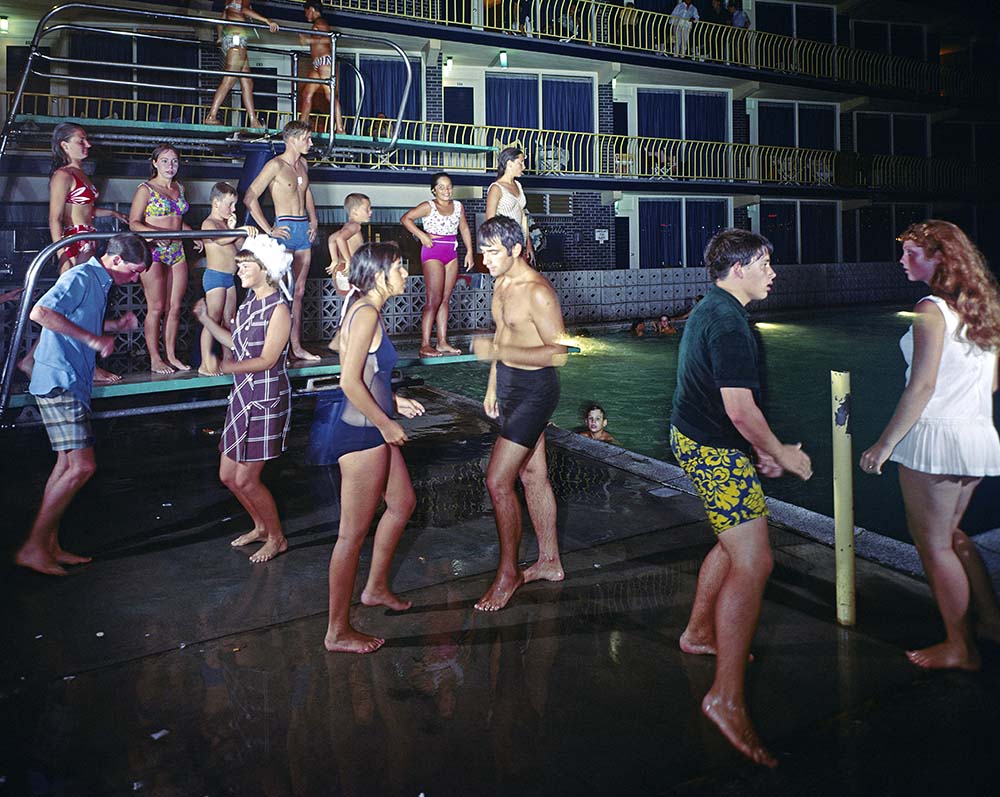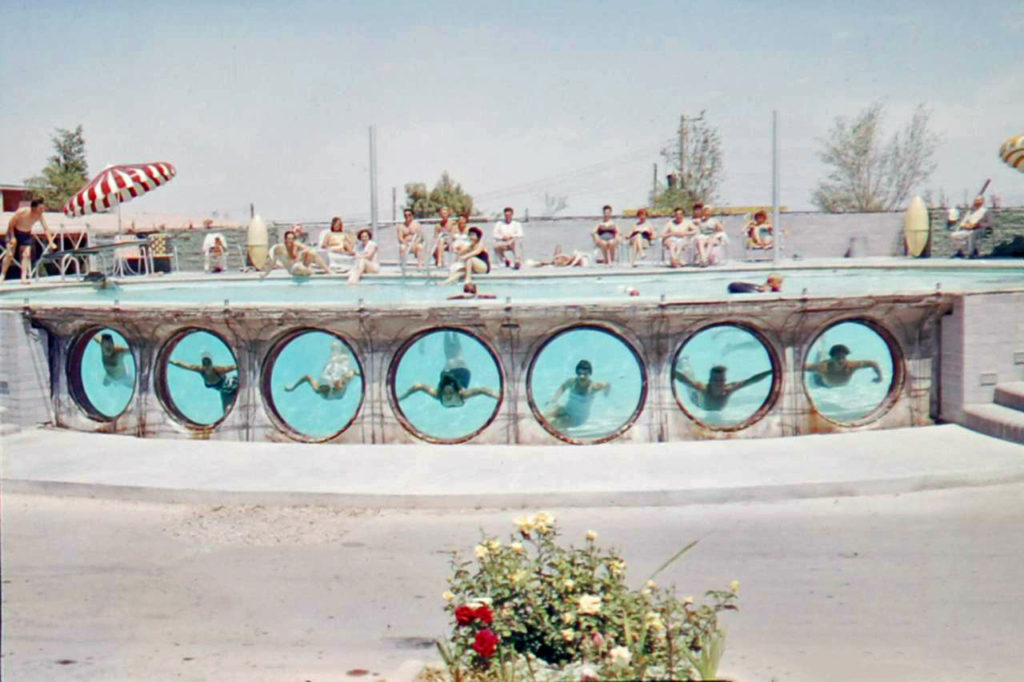“America is a vast conspiracy to make you happy,” John Updike wrote. Forty-six years later, the first half of the sentence holds. The line is from his 1972 story “How to Love America and Leave It at the Same Time,” which begins with a vacationing family choosing a motel. At the top of the list for the kids is “a pool (essential).”
In the new volume, The Swimming Pool in Photography, published by Hatje Cantz, author Francis Hodgson includes iconic and obscure images of sanitarium-style public baths, backyard basins, fascist Olympians, facelifted starlets, and the odd waterslide. Yet it wasn’t the kidney curves of Beverly Hills that brought back the burn of chlorine to my eyes, nor the steam off an Alpine sauna. It’s a handful of photographs showing vacationers at motel pools. Shot on color-drenched Kodachrome and semi-staged, these mostly anonymous photographs advertise a seasonal, obtainable version of the good life. The pools, many of which exist within the same space as the parking lot and the row of numbered doors, speak to a moment in America when average people had the resources to travel, to relax—and to the temporary communities set up around these roadside oases.
Those who know the tedium of the summer road trip—the nausea, the sweat behind the knees—also know the specific joy of a motel marquee, backlit by the evening sun, bearing those four, close-kerned letters. Some say the journey is the destination. I’d trade both journey and destination for the motel pool—not too chilly, not too crowded, within walking distance of a Golden Corral.
Hodgson’s book is a demonstration of how swimming pools are genetically photogenic. Perhaps it’s that a pool somewhat resembles a photograph: a field of glittering action, bordered by white. Or that before digital cameras, to develop a photograph meant to submerge it in a series of three pools—developer, stop bath, fixer. Or that both center around the joys of seeing—light dancing on water, bodies glowing in the sun. Photography might as well have been invented for swimming pools.
But the pools, of course, came first. The earliest known pool was the Great Bath in Mohenjo-Daro, in modern-day Pakistan. Built around 3,000 BC, it had a tar bottom to seal in the water, and was likely used for religious ceremonies. It is now visible on the back of Pakistan’s 20 Rupee note. The excavations at Pompeii revealed an archipelago of public and private swimming pools. Archeologists of the future, if there are any, will make similar discoveries in Miami Beach. Ancient Rome had 800 public baths, some designed for over 1,000 bathers. Interestingly, as the Empire declined, the pools improved. As Charles Sprawson put it in his classic Haunts of the Black Masseur: The Swimmer as Hero, “The more degenerate the emperor, the more sumptuous tended to be his baths.”
“Pools encourage the lowbrow, but allow the highbrow,” writes Francis Hodgson in the book’s accompanying essay. They tempt, and dignify. Horseplay becomes dance, cinderblock becomes Italian marble. The motels were not architectural marvels, though now they possess a certain Midcentury Modern vogue. At the time they were fast-food architecture—thrown up just off the interstates to aid the continental circulation of the American summer. Either single or double storied with rooms that opened directly to the outside, they were designed, much like gas stations, as an extension of the car—and so also of the road, and the home. The motel pool was both yours and not, and you ware both home and not. This third space allowed for a charged familiarity, the feeling of being doubly alive.
A 1966 photograph captioned “Teenagers dancing at the pool of the Admiral Motel in Wildwood, New Jersey” shows just that. It is night, and in the foreground three couples of teens dance to what can only be rock ‘n roll. Their limbs blur in the low light. Four of the dancers are still in their bathing suits, dripping wet. It’s obviously pool water, but it takes on the erotic sheen of sweat. Younger kids watch from the diving board, and even younger ones swim in the pool, tinted green by the underwater lights. Far above are the parents’ occasional glances and shouts to stop running. The concrete is wet and reflective from all the cannonballs. Multiple light sources and knots of drama (each couple lost in their own world) resemble the artifice of a Jeff Wall. But this happened. To look at this picture is to flirt seriously with nostalgia. “Photography is an elegiac art,” Sontag wrote, “a twilight art.”
It would be shortsighted to consider these photographs as simple summertime laudanum.
Like the motels that frame them, they reveal a seedy, if not sinister, fraying of the American project. Eleven years before the impromptu dance party at the Admiral Motel, Loomis Dean took a picture of people in a pool in the outer reaches of Las Vegas, far from the glitz of the Strip. Shooting from the adjacent rundown parking lot, the Life photographer captured two tableaux: on the deck, groups of sunbathers smile for the camera; underwater, seven swimmers float behind seven large portholes. Maybe it’s the potholes in the asphalt, or the old man in the shadows off to the edge of the composition, or the seven people holding their breath—but the five-and-dime optimism of Post-War America seems a bit, well, cheap. Photographs have the ability to time-travel, reappearing—through influence (photographers look at earlier photographers) or dumb luck (photographers have a tendency to photograph the same thing)—in the future. The anxieties of drowning, here treated with bathos, would resurface less than a year later. Loomis Dean photographed the wreck of the SS Andrea Doria ocean liner off Nantucket. Forty-six people died.
That sinking feeling also grips you with Elliott Erwitt’s 1975 photograph of a pool and parking lot at a Florida motel. He shot from the balcony, looking down on a lonely, Lynchian scene. It is late, and the pool and the hot tub are empty. The slide (remember those slippery relics of a less litigious time?) dips down to sip from the surface of the water. Beyond that is a horizon so black that it takes you a moment to register the whisper of breaking waves.
There’s a joke about how horror movies and pornos start the same way: in a motel. By replicating the features of home, motels speak both to our securities and anxieties. Elliott’s vacant pool is unnerving for the same reason that the photograph of the dance party is electric with teenage kicks: the nature of the pool is dependent on its constant, communal use. It does not have the brooding alienation of a private pool behind high shrubs, nor the sweaty surplus of bodies one finds at public pools. It is, like the motel itself, somewhere near occupancy, but not overcrowded.
These motels were razed and rebuilt. Kodachrome gave way to megapixels. The dancing teenagers grew up, stopped dancing. The last gasp of communal leisure is seen in Martin Parr’s The Last Resort, which captures the blight and happiness of the British seashore in the Thatcher years. These photos, all sunburn and soft serve, push the democratic to the extreme. Parr was, incidentally, Margaret Thatcher’s favorite photographer.
The pools got bigger, more complex. Photography changed in step. First were the aerial photographs of Alex Maclean, then Andreas Gursky’s macroviews of capitalist realism. The pools sparkled from above, sapphires set in the concrete of the city. Scaled out, we entered the realm of planetary drama—an unfolding tragedy, it turns out. Concrete and chlorine were never ecologically sound, a fact which grows increasingly difficult to ignore. The more degenerate the Emperor, the more sumptuous the baths.
So how, in a summer where America conspires towards everything but happiness, can a vacation be a return to less degenerate days? Perhaps the answer lies off a highway exit, in a Super 8, a Motel 6—watching the kids splashing in the pool below, sipping a cocktail cooled by hallway-sourced ice.
Hunter Braithwaite has written for Art in America, The White Review, and The Virginian-Pilot. He lives in Miami, where he edits The Miami Rail.
from The Paris Review https://ift.tt/2N2SYHN



Comments
Post a Comment